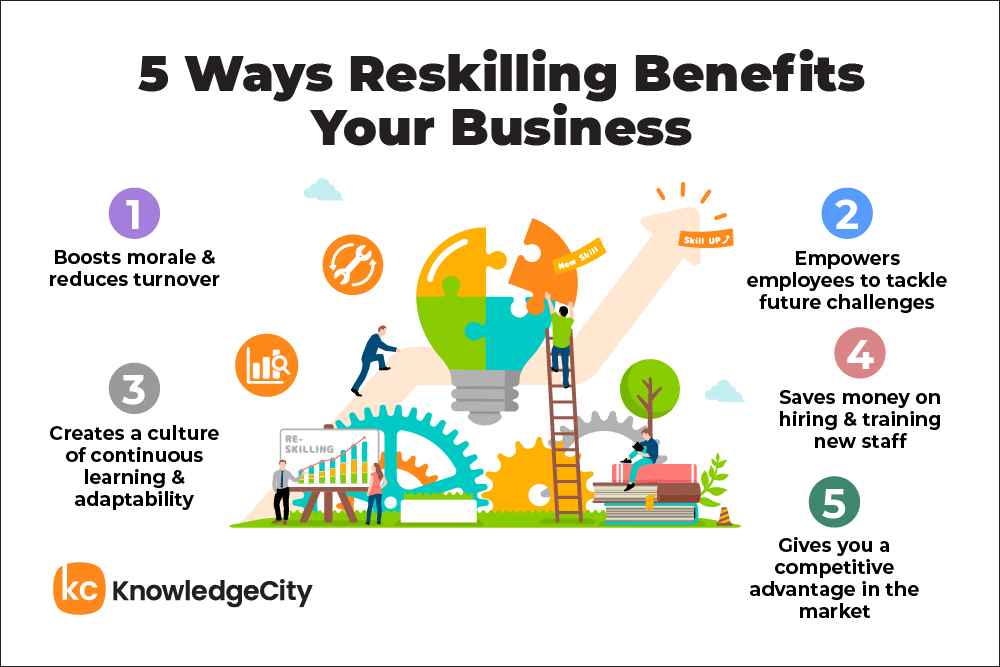Skills are becoming outdated faster due to automation and artificial intelligence, which have the potential to replace many traditional jobs. Harvard Business Review reports that the average half-life of skills is now less than five years, dropping to just two-and-a-half years for some tech fields. To remain valuable in the job market, employees must continuously learn new skills. This article explores the changing business landscape, emphasizes the importance of reskilling, and offers strategies to promote continuous learning in your organization.

Why Is Reskilling Important?
The digital transformation has created new jobs and rendered others obsolete. Employees need proficiency in new software, data analytics, and digital communication tools. Companies that neglect reskilling risk having a workforce lacking in technical skills needed for innovation and growth.
Reskilling can also boost employee morale and job satisfaction. According to McKinsey’s 2023 The State of Organizations Report, 39% of respondents across seven countries said they plan to leave their jobs in the next three to six months, partly due to a lack of professional development opportunities.
When employees are given the opportunity to learn and develop new skills, they feel more engaged and motivated in their roles. This can lead to higher retention rates, a more positive work culture, and a sense of personal achievement.
When employees learn new skills, they become more engaged and motivated, leading to higher retention rates and a positive work culture.
Reskilling also saves companies money by reducing the need to hire and train new employees. This results in a more skilled and efficient workforce, boosting productivity and profitability and maintaining a competitive edge in the market.
How Reskilling Can Future-Proof Your Workforce
A well-executed reskilling strategy can future-proof your workforce in several ways:
- Adaptability: Continuous reskilling enables employees to adjust to new roles and tasks as technology and industries change. This adaptability makes your workforce more versatile and resilient.
- Building a Culture of Continuous Learning: An organizational culture that promotes ongoing learning ensures that employees continually develop and refine their skills. This environment prepares them for future changes and encourages proactive professional development.
- Empowering Employees for Future Challenges: Reskilling provides employees with the skills necessary for current challenges while empowering them to tackle future ones. Confident in their ability to learn and grow, empowered employees are more likely to embrace change and drive innovation.
- Retention: Investing in the development of current employees can increase retention rates. When employees feel valued and have opportunities for growth, they are more likely to stay long-term, saving companies money and nuturing a stable, experienced workforce.
- Creating a Competitive Advantage: A workforce that is continuously reskilled can provide a company with a significant competitive advantage. Skilled employees are able to innovate, improve processes, and adapt to new market conditions more quickly than those at companies without such a strategy.
Steps for Building a Reskilling Strategy
- Identify Skills Gaps: Start by pinpointing areas where your organization lacks essential skills. Use methods like employee surveys, job analysis, and skill assessments to understand these gaps and tailor your reskilling plan accordingly.
- Analyzing Industry Trends: Stay updated on industry trends to anticipate future skill needs. Benchmark against competitors and industry standards to gain insight into the skills your workforce may require.
- Employee Assessments and Feedback: Gather direct feedback from employees through personal development reviews, meetings, and skills assessments. This personalized approach ensures that your reskilling strategy addresses individual strengths and weaknesses.
- Develop a Training Plan: Develop a training plan that incorporates various methods like online courses, workshops, and on-the-job training. Offer a range of options to accommodate different learning styles.
- Utilize E-Learning Platforms: Take advantage of E-learning platforms to provide employees with access to diverse training materials covering technical and soft skills. These platforms offer flexibility and accessibility for learning anytime, anywhere.
- Track Progress and Measure Success: Monitor employees’ progress through regular assessments and evaluations. Measure the success of the program to make necessary adjustments and ensure employees are acquiring the most-desired skills for the future.
Reskilling with KnowledgeCity
Reskilling is vital for companies to stay competitive and up-to-date. By spotting skills gaps, crafting a training plan, and using E-learning platforms to tailor training to individuals’ needs, companies can establish an effective reskilling strategy. This not only boosts employees’ morale and job satisfaction but also prepares the workforce for change by cultivating an adaptable, skilled, and productive team. With a strategic reskilling approach, companies can confidently tackle future challenges.
Subscribe to Our Newsletter
Join 80,000+ Fellow HR Professionals. Get expert recruiting and training tips straight
to your inbox, and become a better HR manager.

 KnowledgeCity
KnowledgeCity 











